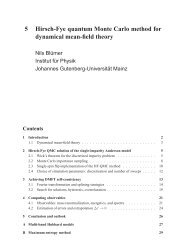Hubbard Model for Asymmetric Ultracold Fermionic ... - KOMET 337
Hubbard Model for Asymmetric Ultracold Fermionic ... - KOMET 337
Hubbard Model for Asymmetric Ultracold Fermionic ... - KOMET 337
You also want an ePaper? Increase the reach of your titles
YUMPU automatically turns print PDFs into web optimized ePapers that Google loves.
Chapter 5Strong coupling limitIn this chapter we will treat a <strong>Hubbard</strong> model with spin-dependent hopping in the strongcoupling limit. We will first investigate the “band structure” of the exactly solvable 2-sitemodel at strong coupling in order to get a first impression of strong coupling behavior andintroduce the concept of effective double occupancy. Then we will explain perturbationtheory <strong>for</strong> the generalized model (5.6) at strong coupling and derive the first and second orderperturbative contributions. The perturbation theory is based on a concept presented in [34].With these results we will analyze the strong coupling limit of the Hamiltonian (5.6), restrictedto nearest neighbor interaction. Finally we will show that under these conditions the U ≫max{t σ } case can be mapped onto a H XXZ model (at half filling) and the U ≪ −max{t σ }case can be mapped onto a hard-core boson model with nearest neighbor interaction (at aneven number of fermions).5.1 Introduction: Exactly solvable 2-site modelIn this section we discuss the exactly solvable 2-site <strong>Hubbard</strong> model with spin-dependenthopping in order to understand its behavior at strong coupling:H = U ∑ in i↑n i↓− ∑ i≠jt σc † iσ c jσ; i,j = 1,2 (5.1)at half filling. The Hilbert space at half filling is ( 42)= 6 dimensional. We introduce thefollowing notation <strong>for</strong> the fully antisymmetric basis states:and analogously <strong>for</strong> the other states.|1 ↑,2 ↓〉 = c † 1↑ c† 2↓|vacuum〉 , (5.2)5.1.1 Diagonalization of the HamiltonianObviously the spin polarized states |1 ↑,2 ↑〉 and |1 ↓,2 ↓〉 are eigenstates with energiesE 1/2 = 0. This reduces our problem to a 4 × 4 matrix problem:The basis is chosen as:H =⎛⎜⎝U −t ↓ −t ↑ 0−t ↓ 0 0 −t ↑−t ↑ 0 0 −t ↓0 −t ↑ −t ↓ U⎞⎟⎠ . (5.3)47













